Travel
Secrets of Reblochon cheese making: visit of a farm in Haute Savoy
While France has more cheese than the numbers of days, only about 10% carry the Appelation d’origine Controllée.
Reblochon has had the AOC designation since 1976 and is one of the most beloved of French cheeses. Its production has increased by 70% in only 12 years.
But what are the secrets of the Reblochon? Have you ever wondered how it is fabricated?
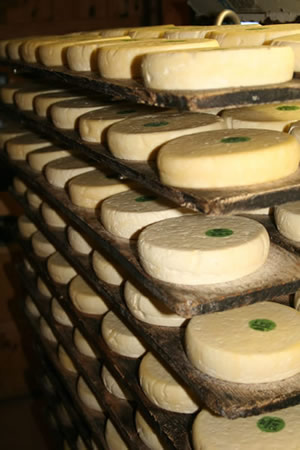
Reblochon stored in a cellar
For those of you not familiar with Reblochon cheese, let’s learn more about the cheese itself and its history:
Reblochon cheese is very soft and smooth and has a little taste of hazelnut. The appearance is yellow with a fine white foam on the top.
The origin of the word comes from the word “reblocher” which means to milk twice. The history of Reblochon comes from the 13th century. Why did the famers milk their cows twice? It was to be able to keep some milk for themselves as the owners of the land wanted to collect the entire milk production. So, farmers milked the cows a little in the morning so that more milch would come in the evening.
With Reblochon you can make a tasty and well-known Savoy dish: the Tartiflette, a baked dish with potatoes, bacon, onions and an entire melted Reblochon cheese. You serve the dish with a chilled white wine.
Life is becoming more and more difficult for small producers of Reblochon Fermier in the Haute Savoy, the region where the cheese comes from. In 2004 out of the 16,900 ton of Reblochon only 3300 ton were produced in farms. Farmers have to compete more than before to market their cheese against larger Reblochon cheese producers.
As Reblochon is one of my favorite cheeses, I always wanted to know more about the secrets of this delicious cheese.
So once, while on vacation in September in the French Alps, I visited an Alpine farm.
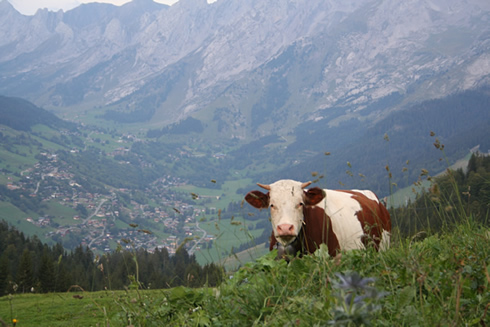
Cow in an alpine field on the Plateau Beauregard in Haute Savoy
I met in the late afternoon with the couple Marie-Louise and Bernard Donzel in their mountain pasture farm of Les Corbassières on the Plateau Beauregard. It is located in La Clusaz in the massif of the Aravis. They live there from mid-May to late September.
During the summer months, they open their doors to tourists with reservations and show them their farm. Marie-Louise prepares delicious homemade snacks and lunches for the occasion.
How is the life as a Reblochon cheese maker?
While making the cheese, Marie-Louise opened up and talked about her life as an agricultural woman, living on the pasture farm five months of the year at 4,920 feet and the rest of the year in their farm in the Confins Valley of La Clusaz.
The couple works hard 365 days a year from the time they get up at 5:30 a.m., to milk their 40 cows (37 of the Abondance race and 3 of the Monbéliarde), until about 10:00 p.m., when they finally go to bed.
They produce about 150 cheeses a day. To keep an AOC appellation, the Donzel needs to milk their cows twice a day, 7 days a week and the milk has to come from one single herd!
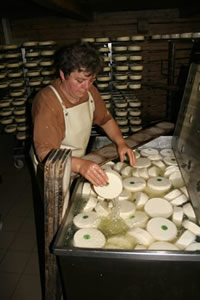
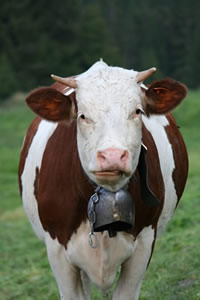
Salting process and one of the Donzel’s cows
Now how do the Donzel’s make their cheese?
Marie Louise measures her milk to calculate how many molds she needs to prepare.
- Then she prepares her molds.
- She put the milk in a big vat. That day she poured 89 gallons in it.
- She adds some rennet (an enzyme produced in a mammal’s stomach), so that it solidifies. One puts 1 drop for each drop of milk. It has real virtues tells me Marie-Louise.
- For 40 minutes Marie Louise manually turns the liquid. She does not let anyone help her, not even her husband. She says she does not trust anyone with it. The grains have to form slowly.
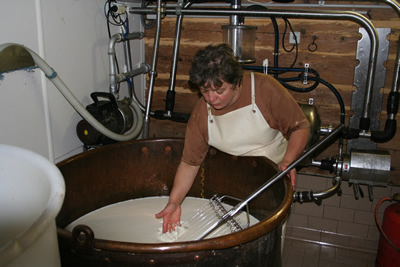
Turn the mich in a vat
It looks like hard work but she says it is not. When the grains start forming, she turns the liquid for 10 minutes with a linen canvas in order to collect the grains.
- Bernard arrives to remove about 2,6 gallons of serum. It will be given back to the cows the next morning.
- The molding process begins. It has to happen fast and for this hard work one needs to be two. The cheese is put into molds.
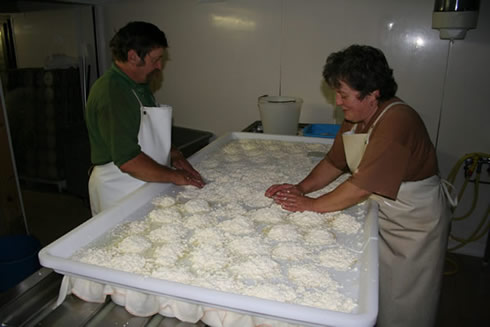
the Donzel forming the Reblochon cheese
- Then a linen canvas, a green dot with a number, a casein plaque, and a weight are laid on top of the cheese. A green dot number is for farmed cheeses and a red one is for factory cheese Reblochons.
- After 15 minutes, the cheeses are turned
- In another room, one can see the salting process. Marie-Louise uses 2,2 pounds of salt for 1,3 gallons of water. She removes the cheese in containers from the morning. They were turned once that day. She will put the new cheeses in it.
- Later, Reblochon cheese will stay in a cool place up to 64 F for 4 days and be placed in the cellar for at least 2 weeks.
Marie-Louise brought me to the cellar and let me touch and taste some of her Reblochons just made or some already more aged. They were excellent. She offered me a couple to bring back home. Some of them I froze as the cheese can be conserved very well in the freezer.
The Donzel’s Reblochon has been praised many times and received medals at the competition of the St.Croix Fair in La Clusaz and several medals at the Paris Agriculture competition.
Have I had made you want to go buy a Reblochon yet? I hope so!
But don’t forget, if you are in the area, stop by the farm of Marie-Louise and Bernard Donzel and taste their great homemade jam, crépes, fruit tartes and above all their soft Reblochon cheese.
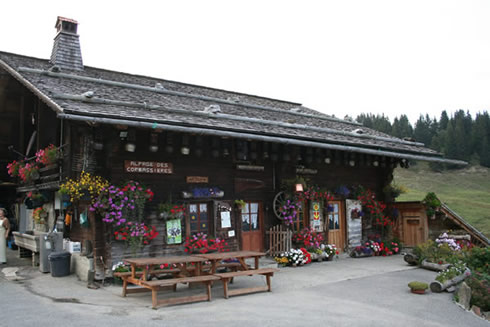
The Alpage chalet des Corbassières
Famille Donzel in the Alpage des Corbassières. Massif de Beauregard in La Clusaz – in the Summer Tel: 0041 (0)4 50 32 63 81

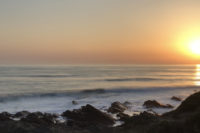

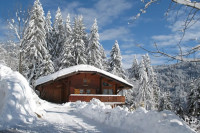
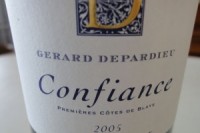

Hello: The Reblochon looks delicious! Can I book a tour with the Donezel’s through this email? I will be in La Clusaz soon, arriving 18th July and leaving the 22nd or 23rd July. I am travelling with my family and another family — we are 10 people in all — and all very interested in cheese production (& eating). Please let me know if it is possible for us to visit. Thank you.
Jane Nishimura
Hi. Glad you liked my article and yes the Reblochon is delicious. If you call the number at the end of the article, you can book directly with Madame Donzel. Otherwise try contacting the tourist office of La Clusaz per phone or email. They can book it for you. Good luck and have a great trip.